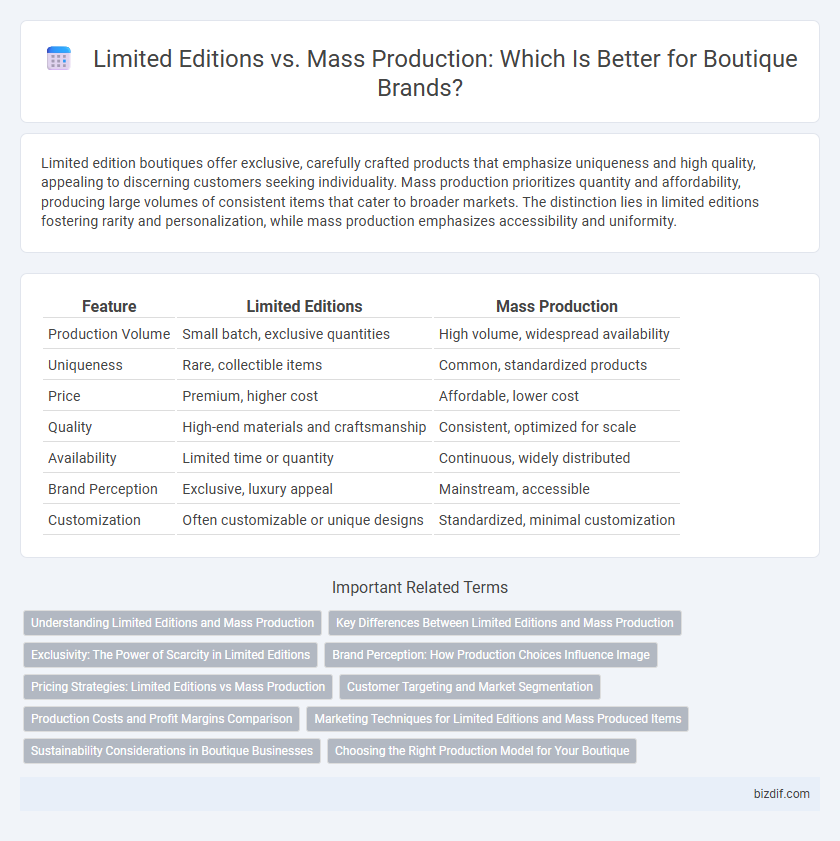Limited edition boutiques offer exclusive, carefully crafted products that emphasize uniqueness and high quality, appealing to discerning customers seeking individuality. Mass production prioritizes quantity and affordability, producing large volumes of consistent items that cater to broader markets. The distinction lies in limited editions fostering rarity and personalization, while mass production emphasizes accessibility and uniformity.
Table of Comparison
| Feature | Limited Editions | Mass Production |
|---|---|---|
| Production Volume | Small batch, exclusive quantities | High volume, widespread availability |
| Uniqueness | Rare, collectible items | Common, standardized products |
| Price | Premium, higher cost | Affordable, lower cost |
| Quality | High-end materials and craftsmanship | Consistent, optimized for scale |
| Availability | Limited time or quantity | Continuous, widely distributed |
| Brand Perception | Exclusive, luxury appeal | Mainstream, accessible |
| Customization | Often customizable or unique designs | Standardized, minimal customization |
Understanding Limited Editions and Mass Production
Limited editions refer to exclusive, carefully crafted products often produced in small quantities to maintain uniqueness and high value, appealing to collectors and discerning customers. Mass production involves manufacturing large volumes of standardized items to maximize efficiency and reduce costs, catering to a broad market with consistent quality. Understanding the distinction helps boutiques strategically position their offerings to balance exclusivity and accessibility while meeting diverse consumer demands.
Key Differences Between Limited Editions and Mass Production
Limited editions offer exclusivity through limited quantities, enhancing perceived value and uniqueness, while mass production emphasizes large-scale manufacturing for widespread availability and cost efficiency. Limited editions typically involve higher craftsmanship, unique designs, and collectible appeal, contrasting with the standardized, uniform products of mass production. The key differences lie in production volume, customization level, pricing strategy, and target market exclusivity.
Exclusivity: The Power of Scarcity in Limited Editions
Limited edition products in boutique settings leverage scarcity to create a sense of exclusivity that mass production cannot match, driving higher perceived value and customer demand. The limited availability fosters a unique connection between the buyer and the product, enhancing brand prestige and loyalty. This strategic use of scarcity transforms each piece into a coveted item, amplifying its desirability and market impact within niche luxury segments.
Brand Perception: How Production Choices Influence Image
Limited editions enhance brand perception by creating exclusivity and scarcity, attracting discerning customers who value uniqueness and craftsmanship. Mass production, while increasing accessibility and market reach, can dilute the brand's luxury appeal and reduce perceived value. Strategic production choices directly shape customer loyalty and the overall prestige associated with a boutique brand.
Pricing Strategies: Limited Editions vs Mass Production
Limited edition products typically command higher prices due to their exclusivity, craftsmanship, and unique appeal, allowing boutiques to leverage scarcity as a key pricing strategy. Mass-produced items benefit from economies of scale, resulting in lower production costs and more competitive pricing aimed at a broader market. Boutique pricing strategies for limited editions focus on perceived value and rarity, whereas mass production pricing centers on volume sales and cost efficiency.
Customer Targeting and Market Segmentation
Limited editions in boutiques target niche customer segments seeking exclusivity, uniqueness, and high perceived value, appealing to collectors and trendsetters willing to pay premium prices. Mass production focuses on broader market segmentation, delivering affordability, accessibility, and consistent product availability to mainstream consumers prioritizing practicality and cost-efficiency. Effective market segmentation enables boutiques to strategically position limited editions as luxury or specialty goods, differentiating from mass-produced items and optimizing customer engagement.
Production Costs and Profit Margins Comparison
Limited edition products typically have higher production costs due to smaller batch sizes and premium materials, resulting in increased exclusivity and brand value. Mass production benefits from economies of scale, lowering per-unit costs but often reducing profit margins per item due to price competition. Boutique brands leverage limited editions to achieve higher profit margins by targeting niche markets willing to pay a premium for uniqueness and craftsmanship.
Marketing Techniques for Limited Editions and Mass Produced Items
Limited edition products leverage scarcity marketing by emphasizing exclusivity and unique features, driving higher perceived value and urgency among consumers. Mass-produced items utilize broad distribution and consistent branding to maximize accessibility and reinforce brand recognition. Targeted storytelling and personalized experiences enhance the appeal of limited editions, while mass production benefits from economies of scale and standardized quality assurance.
Sustainability Considerations in Boutique Businesses
Limited edition products in boutique businesses reduce waste by producing smaller quantities tailored to demand, minimizing excess inventory and environmental impact. Mass production often leads to overproduction, contributing to resource depletion and increased carbon footprints due to large-scale manufacturing processes. Sustainable boutique practices prioritize craftsmanship and eco-friendly materials, ensuring each limited edition item supports ethical consumption and reduces overall environmental harm.
Choosing the Right Production Model for Your Boutique
Limited editions create exclusivity and increase perceived value, attracting discerning boutique customers seeking unique products. Mass production offers cost efficiency and consistent supply, ideal for boutiques aiming to scale and maintain inventory levels. Boutique owners must evaluate market demand, brand identity, and profit margins to select the optimal production model that aligns with their business goals.
Limited Editions vs Mass Production Infographic

 bizdif.com
bizdif.com